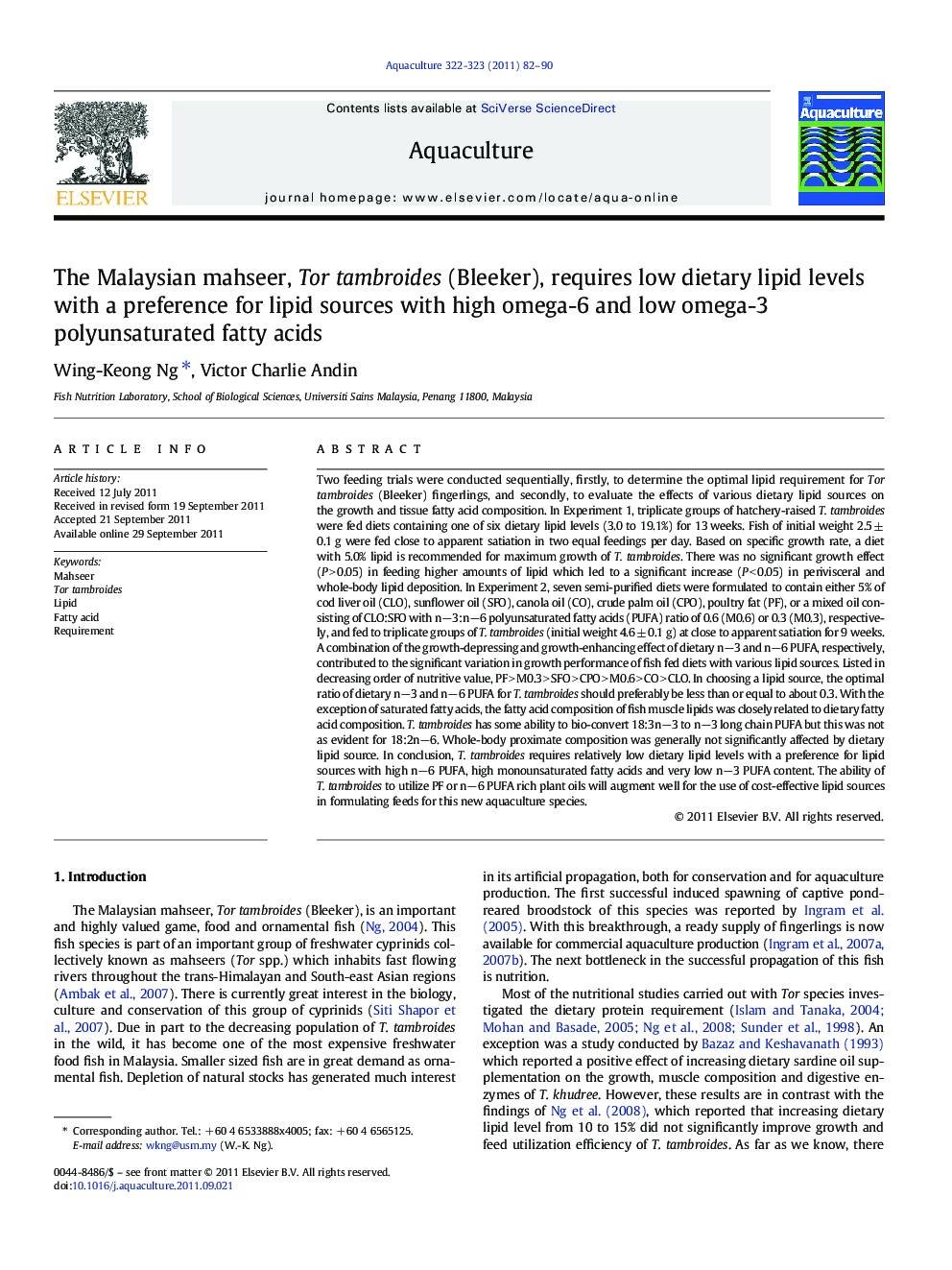| کد مقاله | کد نشریه | سال انتشار | مقاله انگلیسی | نسخه تمام متن |
|---|---|---|---|---|
| 2422809 | 1552898 | 2011 | 9 صفحه PDF | دانلود رایگان |

Two feeding trials were conducted sequentially, firstly, to determine the optimal lipid requirement for Tor tambroides (Bleeker) fingerlings, and secondly, to evaluate the effects of various dietary lipid sources on the growth and tissue fatty acid composition. In Experiment 1, triplicate groups of hatchery-raised T. tambroides were fed diets containing one of six dietary lipid levels (3.0 to 19.1%) for 13 weeks. Fish of initial weight 2.5 ± 0.1 g were fed close to apparent satiation in two equal feedings per day. Based on specific growth rate, a diet with 5.0% lipid is recommended for maximum growth of T. tambroides. There was no significant growth effect (P > 0.05) in feeding higher amounts of lipid which led to a significant increase (P < 0.05) in perivisceral and whole-body lipid deposition. In Experiment 2, seven semi-purified diets were formulated to contain either 5% of cod liver oil (CLO), sunflower oil (SFO), canola oil (CO), crude palm oil (CPO), poultry fat (PF), or a mixed oil consisting of CLO:SFO with n−3:n−6 polyunsaturated fatty acids (PUFA) ratio of 0.6 (M0.6) or 0.3 (M0.3), respectively, and fed to triplicate groups of T. tambroides (initial weight 4.6 ± 0.1 g) at close to apparent satiation for 9 weeks. A combination of the growth-depressing and growth-enhancing effect of dietary n−3 and n−6 PUFA, respectively, contributed to the significant variation in growth performance of fish fed diets with various lipid sources. Listed in decreasing order of nutritive value, PF > M0.3 > SFO > CPO > M0.6 > CO > CLO. In choosing a lipid source, the optimal ratio of dietary n−3 and n−6 PUFA for T. tambroides should preferably be less than or equal to about 0.3. With the exception of saturated fatty acids, the fatty acid composition of fish muscle lipids was closely related to dietary fatty acid composition. T. tambroides has some ability to bio-convert 18:3n−3 to n−3 long chain PUFA but this was not as evident for 18:2n−6. Whole-body proximate composition was generally not significantly affected by dietary lipid source. In conclusion, T. tambroides requires relatively low dietary lipid levels with a preference for lipid sources with high n−6 PUFA, high monounsaturated fatty acids and very low n−3 PUFA content. The ability of T. tambroides to utilize PF or n−6 PUFA rich plant oils will augment well for the use of cost-effective lipid sources in formulating feeds for this new aquaculture species.
► We determined the optimal dietary lipid level and source for Tor tambroides.
► A diet with 5.0% lipid is recommended for maximum growth.
► The optimal ratio of dietary n−3 to n−6 PUFA should be less than or equal to 0.3.
► Poultry fat is a good source of lipid for this fish.
► T. tambroides has some ability to bioconvert 18:3n−3 to n−3 long chain PUFA.
Journal: Aquaculture - Volumes 322–323, 21 December 2011, Pages 82–90